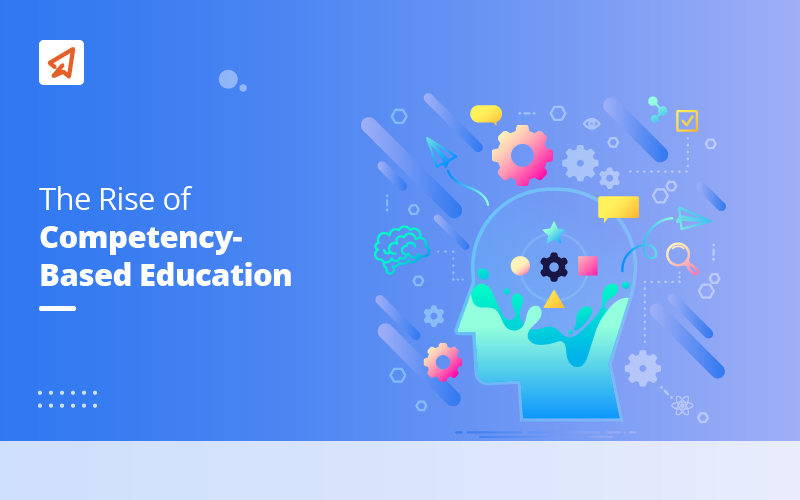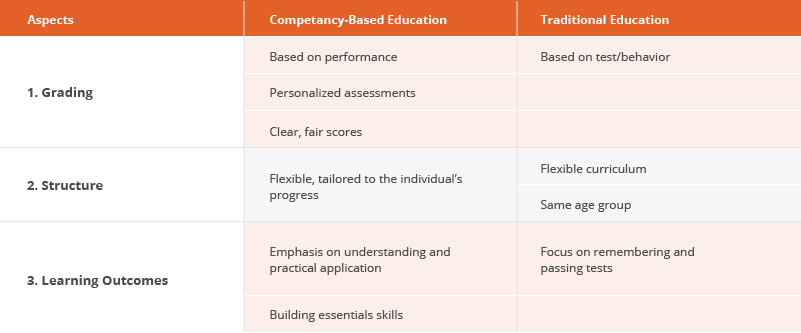The Rise of Competency-Based Education (CBE)

Competency-based education (CBE) is changing how we usually teach and learn, and recent data shows it has some great advantages. A survey found that over 82% of people think CBE will grow nationally in the next five years.
Before, the path through education was straightforward: finish high school, go to college, and start working. But CBE is shaking things up by offering new ways to learn. It focuses on building skills, always learning, and growing in your career. This blog explores why more higher education places are getting interested in the benefits of competency-based education.
What Is Competency-Based Education (CBE)?
Competency-based education (CBE) is a modern way of learning and getting better at specific skills. Instead of learning for a specific amount of time, CBE focuses on mastering certain skills. In CBE, students move forward when they show they’re really good at specific things, making learning more flexible and personalized. This method works well for adults, people with different learning styles, and those aiming to learn practical, job-related skills.
CBE has become popular recently. A survey in 2016 found that almost 95% of schools were interested in trying CBE, showing that many recognize its advantages and how it can fit different learning needs and situations.
82% PRINCIPALS prefer Extramarks because it gives teachers confidence to cover syllabus depth
What’s the Difference Between Competency-Based Education and Traditional Education?
-
Grading
In regular grades, your score comes from tests, assignments, and how you behave. But with competency-based education, it’s all about how well you perform, and there’s no unfairness.
Teachers use personalized and creative assessments to learn about your progress. Then, they make scores that are clear and help you and your parents understand how you’re really doing.
-
Structure
In a normal school, everyone follows a fixed plan for the whole year. So, after each unit, everyone moves forward, even if they don’t completely understand the stuff or master the skills. All students in a class have to be the same age.
But in competency-based education, things are more flexible. It’s about you and where you are in learning. You get the support you need to move forward and get really good at the subject. Instead of moving forward because of your age, you move forward based on what you know and can do.
-
Learning Outcomes
In regular learning, the outcomes are mainly about remembering and understanding to pass tests.
But in competency-based learning, the emphasis is on really understanding things and showing it by doing. Learning outcomes are about proving what you can do, and they’re all about building the skills you need to be a better learner as you grow up.

Key Characteristics Of Competency-Based Learning (CBL)
-
Outcomes-Based
In outcomes-based learning, CBL usually begins with clear learning goals. The plan for CBL involves creating, organizing, and connecting groups of skills to learning materials, guidelines, and evaluations, along with tools to track how well you’re doing. Putting outcomes first, it helps teachers and faculty members:
- Rearrange how lessons are planned, starting with what students should learn instead of following a strict schedule.
- Create strong sets of skills and learning goals.
- Encourage real tests that show students have mastered the skills.
- Make excellent tests, share resources, and guidelines designed to help students achieve learning goals.
- Provide a clear analysis of what a student has learned at every level of the school.
- Spot problems in student’s progress toward learning goals and give the right help.
- Improve academic performance in the short and long term, focusing on what students achieve rather than just what students put in.
-
Learner-Centric
Competency-based learning is all about putting the focus on each student as an individual. It gives lots of chances for every student to learn the skills they need at their own speed, gather proof of what they’ve learned, work together with other students, and become learners for life. It helps students:
- Move forward in learning without being rushed by time.
- Know the different skills they need to be good at to reach their goals.
- Work together with mentors and classmates in learning activities.
- See what they’ve learned, where they need help, what’s left to do, and how they can get better in academics.
- Try out different ways of learning.
- Think about and understand their own learning accomplishments.
- Make things that show what they’re good at.
- Build an online identity to manage skills and show what they’ve learned from different places.
-
Differentiated
Differentiation in competency-based learning means using teaching methods that understand and adjust to each learner’s needs. It covers a lot of things, like how learners talk, the help they get, and the support they need.
Interventions – Giving learners good feedback and guidance helps them move forward in their learning and get better at the skills they’re learning.
Diagnostic – Students get tests and different learning materials that match the skills they already know. It’s like figuring out what they’re good at and giving them the right things to learn.
Choice of Learning – Learners can pick learning things based on what they like and what works best for them.
Affiliation – Learners can get different online training materials based on how they relate to the programs in their groups.
Personalized Message – Learners get messages that are just right for them – they’re about what each learner needs and come at the right time.


Features Of the Competency-Based Education (CBE) Approach
Structure – In how things are set up:
- They make sure everyone knows what it means to be really good at something.
- Schools and districts want to be clear and open about how students learn.
- Ways of showing progress help students learn better and do well.
- Moving forward is based on what students have learned (mastered) through personalized learning paths.
Purpose and Culture – Why things are done and what it’s like:
- They want students to succeed not just in school, but forever.
- Schools and districts are serious about learning.
- Schools and districts create a culture where everyone is included and feels powerful in their learning.
Pedagogy – How teachers teach:
- Teachers help students at the right time and in the way they need.
- They use research-backed ways of teaching that focus on where students are and getting them excited to learn.
Benefits Of Competency-Based Education (CBE)
1. Flexible Self-Paced Learning
In regular school, students have to stick to the timetable made by teachers. But with Competency-Based Education (CBE), it’s different!
CBE lets students learn at their own speed, giving them more freedom in education. As a teacher, you can decide on different things students should learn before the session starts and keep track of how each student is doing.
2. Classes Emphasize Measurable Competencies that Help Build Skills for Life
Competencies, or things students should learn, are set before and become goals for each student.
What are these goals based on?
Instead of just testing what students know in their head, skills in CBE focus on how well they understand and use the subject in real situations.
These skills can be based on:
- Understanding important ideas
- Applying knowledge to real problems
- Mastering useful skills
To measure the results, these skills must be decided on in advance by school leaders. It’s not something you do alone – get ideas from the whole teaching staff to figure out what knowledge and skills are needed to show mastery.
3. Moving Forward in Learning
Teachers look at data and check how well each student is doing on the learning journey. When students clearly understand a topic, show they’ve gained important skills, and prove they can use what they know, it makes sense for them to move forward.
4. Application-oriented Learning
In competency-based education, it’s all about using what you know in real life. Students learn by doing hands-on projects, solving problems, and having practical experiences. This helps them understand concepts better and see how they apply in the real world.

5. Teachers Assess for Growth and Mastery
Checking how much a student has learned and how good they’ve become is important for teachers. There are different ways they do this. Here are three kinds that work really well for competency-based education:
- Authentic Assessments
Authentic assessments work really well because teachers ask students to use what they know in real-life situations. It’s like applying your knowledge to things you might do in the future. For example, students might use their English skills to write a cover letter for a job or use physics to build a tower out of toothpicks and marshmallows.
- Formative Assessments
Formative assessments show teachers the areas where students can get better, and they can adjust things right away to help them improve. It’s like getting feedback in the middle of the game, showing what one needs to work on right away.
- Digital Content Assessment
When we use technology in class, checking how well students are doing becomes much simpler. Many smart classroom providers like Extramarks offer assessments and progress reports. This helps teachers know exactly where each student is in their learning.
Extramarks Offers Smart Solutions for School Assessments
Extramarks Smartclass Plus makes classrooms fun and student-focused. And, the Extramarks Assessment Centre enhances assessments with tools, feedback features, reports, and smart tech for quick, accurate grading.
Learn More6. Students Get Personal Support
In a competency-based education setup, students should know how long they can try to solve a problem before getting help. They also know when it’s okay to ask the teacher during class.
Competency-based education is fair and doesn’t show favouritism. So, as teachers help students with their different challenges and build on their strengths, every student moves ahead on their own path to mastering the subject. Each student gets a chance to succeed in their own way.
For this to work well, teachers need to be there for students. And it’s not just about waiting for students to ask for help—teachers need to know how each student is doing all the time.
7. Global Edge to Careers
Competency-based education focuses on upgrading skills, giving students a strong advantage in their careers on a global scale. This approach ensures that students are well-prepared to excel in various job opportunities around the world.
This means that Competency-Based Education (CBE) creates excellent chances for your students to be employed in the best ways.
8. Equity is Set Before All Else
Fairness in education doesn’t mean giving everyone the same stuff. It means giving each student what they need to reach the same goal.
Competency-based education follows this rule. It wants to understand and eliminate any unfairness in school leadership. Students are taught and helped based on what they’re good at and where they need help. This way, everyone has the same chance to succeed. It removes the idea that where you come from or the language you speak affects how well you can do.
Competency-based education also ensures that all students feel safe and respected, creating a welcoming and inclusive atmosphere.
9. Holistic Skill Development
Competency-based education helps students learn more than just academic stuff. It focuses on important skills like thinking critically, being creative, communicating well, working together, and adapting to different situations. This way, students become all-around smart and ready to handle real-life challenges.
10. Cost-Efficiency
Competency-based education can be a money-smart choice for students. Since they can go at their own speed and maybe finish courses faster, they can save on tuition costs and have less student loan debt. It’s a good financial option for lots of learners.
11. Increased Engagement
In Competency-Based Education (CBE), learning is more interesting because it uses fun and interactive materials. This can be things like simulations, case studies, and hands-on activities that grab students’ attention, making learning more fun and better.
12. Credentialing Flexibility & Improved Retention
In CBE, students can get small credentials and certificates for specific skills as they go along, making them more adaptable for jobs. CBE’s main focus on mastering skills helps more students finish their courses and remember what they learn, so they understand subjects better.
Competency-Based Education Models

-
School Systems
School systems, whether they’re state, district, or other educational groups, are in charge of building and maintaining competency-based education systems in the schools they work with.
When school systems play a part in deciding how their schools’ competency-based education works, it makes things consistent and clear across the whole network. This helps teachers know exactly what mastering a subject looks like, which skills are important, and what assessments to use. But, it still lets them be flexible on a local level.
-
Student Experience
How students experience school depends on how the learning setup is planned. This means making things accessible to everyone and letting students take different paths to success.
After that, teachers need to give each student personal instruction, feedback, and help. Students should learn in a way that builds on what they already know and involves different ways like practicing, talking about it, and doing projects.
Lastly, assessments should show that students really know the subject. That way, all students can move forward when they’re really good at it.
-
Professional Practice
Teachers need the right tools, like data and learning systems, to do their job well. This helps them give clear feedback and make their teaching better. Teachers should also set up the classroom so that everyone feels included, builds relationships, and gets really good at the subjects.
All school staff play a part in building relationships too. For a strong competency-based education system, teachers need to connect with each other, with students, and with parents to make lessons fit everyone.
The professional practice model of competency-based education also means always getting better. Everyone involved in students’ learning and progress should keep improving themselves and how they teach, using research and student data.
-
School Culture
To bring all these models together, the school culture is what makes a competency-based education system work actively. Each model mentioned above plays a big role in creating a school culture that welcomes and uses the competency-based learning system to help all students.
A thriving school culture embraces values such as inclusivity, equity, empowerment, and flexibility.
How to Move Towards Implementing Competency-Based Education
Moving to CBL involves five main changes. Each shift offers a way for teachers and school leaders to make the transition, and there’s no strict order to follow. These shifts are often adapted based on the strengths and areas for improvement in the school. Here are some examples of how schools start making these shifts:
1. From Content-Driven to Skills-Driven:
Create a graduate profile that focuses on teaching skills that last and can be used in different situations. Incorporate a flipped classroom approach, where students engage with lecture materials at home and use class time for hands-on practice and application of skills.
90% TEACHERS SAY EXTRAMARKS’ INTERACTIVE MODULES MAKE CLASSES COME ALIVE
2. From Time-Based to Performance-Based:
Look at how time plays a big role in how grades are given at your school. Use online tools and retesting methods to make the assessment system more flexible.

3. From Grading to Feedback:
Explore and get knowledge on good grading practices to make feedback more clear, fair, and meaningful.
4. From Lessons to Experiences:
Change final assessments to be tasks that relate more to real-life situations. Utilize flipped classroom strategies to turn traditional lessons into interactive experiences that deepen understanding and practical application.
5. From Educator Designed to Co-Designed:
Understand the idea of agency and give students chances to set, work towards, and think about their own goals.
Competency-based education is not just a trend; it’s a transformative approach to reshaping the future of learning. Its focus on skills, flexibility, and personalized learning is unlocking new potentials for students worldwide. As we navigate these shifts in education, embracing CBE opens doors to a brighter, more inclusive, and adaptable learning future.
Last Updated on February 13, 2025
Reviewed by

Priya Kapoor | AVP - Academics
Priya Kapoor is an accomplished education professional with over 18 years of experience across diverse fields, including eLearning, digital and print publishing, instructional design, and content strategy. As the AVP – Academics at Extramarks, she leads academic teams in creating tailored educational solutions, ensuring alignment with varied curricula across national and international platforms...read more.










